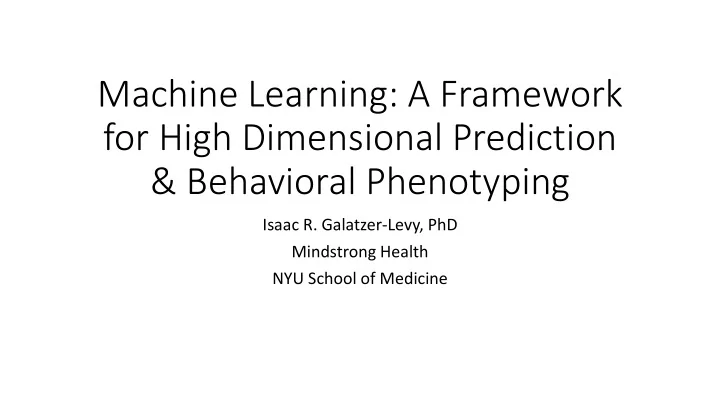

Machine Learning: A Framework for High Dimensional Prediction & Behavioral Phenotyping Isaac R. Galatzer-Levy, PhD Mindstrong Health NYU School of Medicine
Disclosure • Equity and salary from Mindstrong Health
1. Personalized medicine problem • Differential response to treatment • Variable & multidetermined treatment effect • Strong effects in subpopulations are washed out by averaging across responders and non-responders • The ability to predict responders to Tx [x 1 … x n ] can solve this problem
2. Phenotyping problem • Current clinical definitions • Heuristic • Heterogeneous • Distant from the behavioral and biological phenotypes used in basic and translational models • Good treatments are lost in translation
Personalized medicine problem 1. Breast cancer tissues 2. Normal tissues 3.
Basic principles of classification • Want to classify objects as boats and houses. 6
Basic principles of classification • All objects before the coast line are boats and all objects after the coast line are houses. • Coast line serves as a decision surface that separates two classes. 7
Basic principles of classification These boats will be misclassified as houses 8
Basic principles of classification This house will be misclassified as a boat 9
High Dimensional Classification
Neural Networks for Deep Learning
Hot Dog Not Hot Dog
Phenotyping problem • Need for new ways to define clinical populations that move away from heuristic description of mental health towards direct behavioral and biological phenotyping • Problem • High dimensional data • No clear clinical interpretation
Diagnostic Status DSM 5 DSM-IV 8 8 6 6 4 4 2 2 PTSD + PTSD + 0 0 PTSD - PTSD - n= 79,794 n=636,120 6-17 symptoms 6-20 symptoms
Digital Phenotyping
p n X = Orthogonal Basis
Now what?
Thank You
Latent Growth Mixture Modeling T1 T2 T3 T4 I S Q C
Now what?
Latent Growth Mixture Modeling • I,S,Q=>C Chronic Recovery Resilience Time
Freezing
Freezing
Role of FKBP5 on Patterns of Fear Potentiated Startle During Extinction • Combined Iraq and Afghan War Vets and Grady ER Sample n= 721 3 0 M o d a l F P S E xtin g u ish e rs * F e a r P o te n tia te d S ta rtle { High FPS Extinguishers: RS1360780 TT=33.33% H ig h F P S E x tin g u ish e rs H ig h F P S N o n -E x tin g u is h e rs Model Responders: RS1360780 2 0 TT=10.87% Wald (1, 97) = 3.70, p<= .05 1 0 High FPS Extinguishers: RS1360780 TT=50.00% { 0 In tru s io n s A v o id a n c e /N u m b in g H y p e ra ro u s a l Model Responders: RS1360780 TT=16.30% Wald (1, 97) = 3.67, p<= .05 P T S D S y m p to m C lu s te rs
HPA-Axis Augmentation of Extinction and Recall n= 127 4 * * * N o n -H ig h D o se D e x N o n -E x tin g u ish e rs * * * fk b p 5 m R N A N o n -H ig h D o se D e x E x tin g u is h e rs 3 * * * H ig h D o se D e x E x tin g u is h e rs 2 A m y g d a la 1 0 n l l o a i c t c e R n i - t t x s E o - P t s o P Galatzer-levy, et. al. ( In Press ); Neuropharmacology
Problems in Clinical Trial Research • Variable & multidetermined treatment effects • Personalized medicine problem • Heuristic based clinical constructs • Behavioral phenotyping problem
Recommend
More recommend